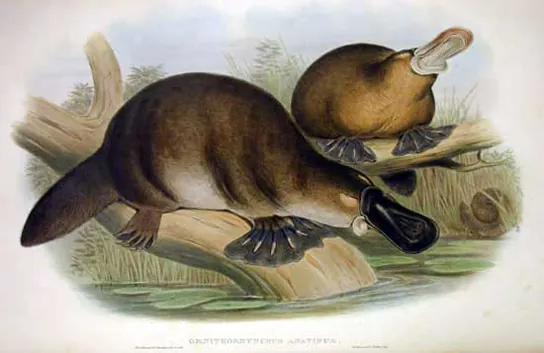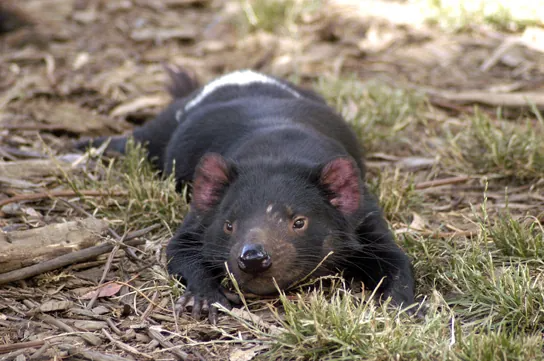29.6 Mammals
Learning Objectives
- Name and describe the distinguishing features of the three main groups of mammals
- List some derived features that may have arisen in response to mammals’ need for constant, high-level metabolism
- Identify the major clades of eutherian mammals
Mammals, comprising about 5,200 species, are vertebrates that possess hair and mammary glands. Several other characteristics are distinctive to mammals, including certain features of the jaw, skeleton, integument, and internal anatomy. Modern mammals belong to three clades: monotremes, marsupials, and eutherians (or placental mammals).
Characteristics of Mammals
The presence of hair, composed of the protein keratin, is one of the most obvious characteristics of mammals. Although it is not very extensive or obvious on some species (such as whales), hair has many important functions for most mammals. Mammals are endothermic, and hair traps a boundary layer of air close to the body, retaining heat generated by metabolic activity. Along with insulation, hair can serve as a sensory mechanism via specialized hairs called vibrissae, better known as whiskers. Vibrissae attach to nerves that transmit information about tactile vibration produced by sound sensation, which is particularly useful to nocturnal or burrowing mammals. Hair can also provide protective coloration or be part of social signaling, such as when an animal’s hair stands “on end” to warn enemies, or possibly to make the mammal “look bigger” to predators.
Unlike the skin of birds, the integument (skin) of mammals, includes a number of different types of secretory glands. Sebaceous glands produce a lipid mixture called sebum that is secreted onto the hair and skin, providing water resistance and lubrication for hair. Sebaceous glands are located over most of the body. Eccrine glands produce sweat, or perspiration, which is mainly composed of water, but also contains metabolic waste products, and sometimes compounds with antibiotic activity. In most mammals, eccrine glands are limited to certain areas of the body, and some mammals do not possess them at all. However, in primates, especially humans, sweat glands are located over most of the body surface and figure prominently in regulating the body temperature through evaporative cooling. Apocrine glands, or scent glands, secrete substances that are used for chemical communication. Mammary glands produce milk that is used to feed newborns.
The adductor muscles that close the jaw comprise two major muscles in mammals: the temporalis and the masseter. Working together, these muscles permit up-and-down and side-to-side movements of the jaw, making chewing possible—which is unique to mammals. Most mammals have heterodont teeth, meaning that they have different types and shapes of teeth (incisors, canines, premolars, and molars) rather than just one type and shape of tooth. Most mammals are also diphyodonts, meaning that they have two sets of teeth in their lifetime: deciduous or “baby” teeth, and permanent teeth. Most other vertebrates with teeth are polyphyodonts, that is, their teeth are replaced throughout their entire life.
Mammals, like birds, possess a four-chambered heart; however, the hearts of birds and mammals are an example of convergent evolution, since mammals clearly arose independently from different groups of tetrapod ancestors. Mammals also have a specialized group of cardiac cells (fibers) located in the walls of their right atrium called the sinoatrial node, or pacemaker, which determines the rate at which the heart beats. Mammalian erythrocytes (red blood cells) do not have nuclei, whereas the erythrocytes of other vertebrates are nucleated.
The kidneys of mammals have a portion of the nephron called the loop of Henle or nephritic loop, which allows mammals to produce urine with a high concentration of solutes—higher than that of the blood. Mammals lack a renal portal system, which is a system of veins that moves blood from the hind or lower limbs and region of the tail to the kidneys. Renal portal systems are present in all other vertebrates except jawless fishes. A urinary bladder is present in all mammals.
Turbinate bones (chonchae in humans) are located along the sides of the nasal cavity, and help warm and moisten air as it is inhaled. The pelvic bones are fused in mammals, and there are typically seven cervical vertebrae (except for some edentates and manatees). Mammals have movable eyelids and fleshy external ears (pinnae), quite unlike the naked external auditory openings of birds. Mammals also have a muscular diaphragm that is lacking in birds.
Mammalian brains also have certain characteristics that differ from the brains of other vertebrates. In some, but not all mammals, the cerebral cortex, the outermost part of the cerebrum, is highly convoluted and folded, allowing for a greater surface area than is possible with a smooth cortex. The optic lobes, located in the midbrain, are divided into two parts in mammals, while other vertebrates possess a single, undivided lobe. Eutherian mammals also possess a specialized structure, the corpus callosum, which links the two cerebral hemispheres together. The corpus callosum functions to integrate motor, sensory, and cognitive functions between the left and right cerebral cortexes.
There are three major groups of living mammals:
Monotremes (prototheria): Platypus, echidnas (spiny anteaters)
Monotremes are unique among mammals because they lay eggs, rather than giving birth to live young. The shells of their eggs are not like the hard shells of birds, but have a leathery shell, similar to the shells of reptile eggs.

Marsupials (metatheria): Kangaroo, koal, bandicoot, Tasmasian devil, opossum
Like monotremes, the embryos of marsupials are nourished during a short gestational period (about a month in kangaroos) by a yolk-sac placenta, but with no intervening egg shell. Some marsupial embryos can enter an embryonic diapause, and delay implantation, suspending development until implantation is completed. Marsupial young are also effectively fetal at birth. Most, but not all, species of marsupials possess a pouch in which the very premature young reside, receiving milk and continuing their development. In kangaroos, the young joeys continue to nurse for about a year and a half.

Placental (eutheria) mammals
Eutherian mammals are sometimes called “placental mammals” because all species possess a complex chorioallantoic placenta that connects a fetus to the mother, allowing for gas, fluid, and nutrient exchange. There are about 4,000 species of placental mammals in 18 to 20 orders with various adaptations for burrowing, flying, swimming, hunting, running, and climbing. In the evolutionary sense, they have been incredibly successful in form, diversity, and abundance.
Activity
Now that you have learned about vertebrates, test your knowledge by playing this Materia game “Name that Animal! (Vertebrate edition).”
Link to Learning
Watch the Crash Course Biology summary video on chordates.

